You’ll find Sedona’s red rocks invite you to move—hike jagged ridges at sunrise, cruise scenic byways, and pause at chapels and art galleries that feel carved from the landscape. Trails range from easy strolls to steep scrambles; there are vortex sites, stargazing dark-sky pockets, and cool creek swims when the heat hits. I’ll lay out the top 25 experiences so you can pick what fits your pace—and save the best for last.
Hike Cathedral Rock
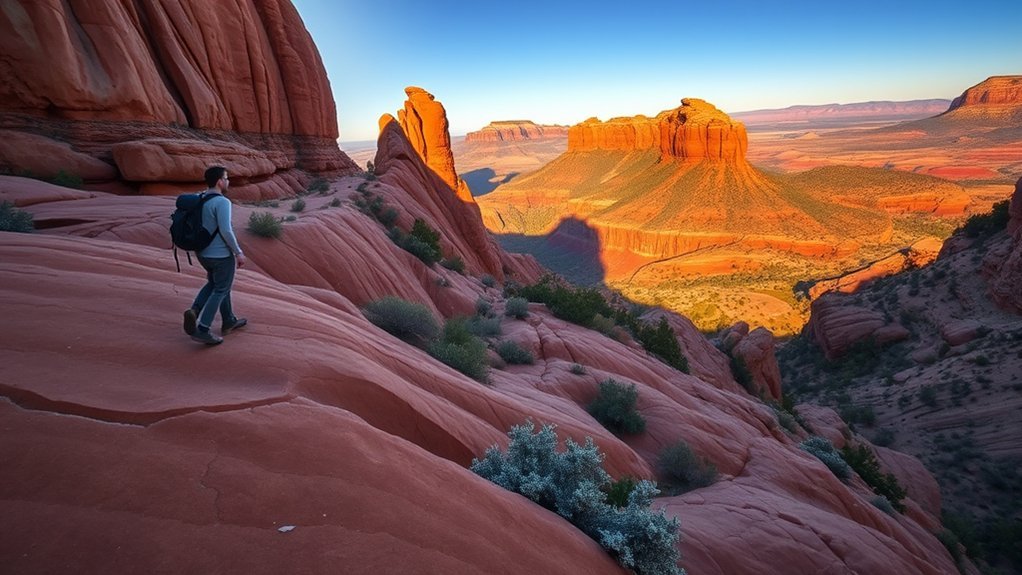
Tackle Cathedral Rock early in the morning to beat the heat and the crowds—this short but steep trail rewards you with dramatic red-rock fins, narrow sandstone steps, and sweeping views of Oak Creek Canyon. You’ll start on well-marked paths that quickly become rocky scramble; bring sturdy shoes and use your hands on iron rungs and natural holds. The ascent is brief but intense: expect loose gravel, carved steps, and brief exposure where balance matters. Pause on ledges to study striations, desert wildflowers, and sunlight painting the buttes gold. At the saddle, you’ll get panoramic vistas of layered mesas and distant Verde Valley — a great spot for photos, snacks, and breathing deeply. Water, sun protection, and modest pacing make the climb safer and more enjoyable. Dogs are allowed but need to be fit for the terrain. On descent, watch footing and follow cairns to the trailhead; avoid short-cutting to protect fragile vegetation and fragile sandstone.
Explore Bell Rock Trail
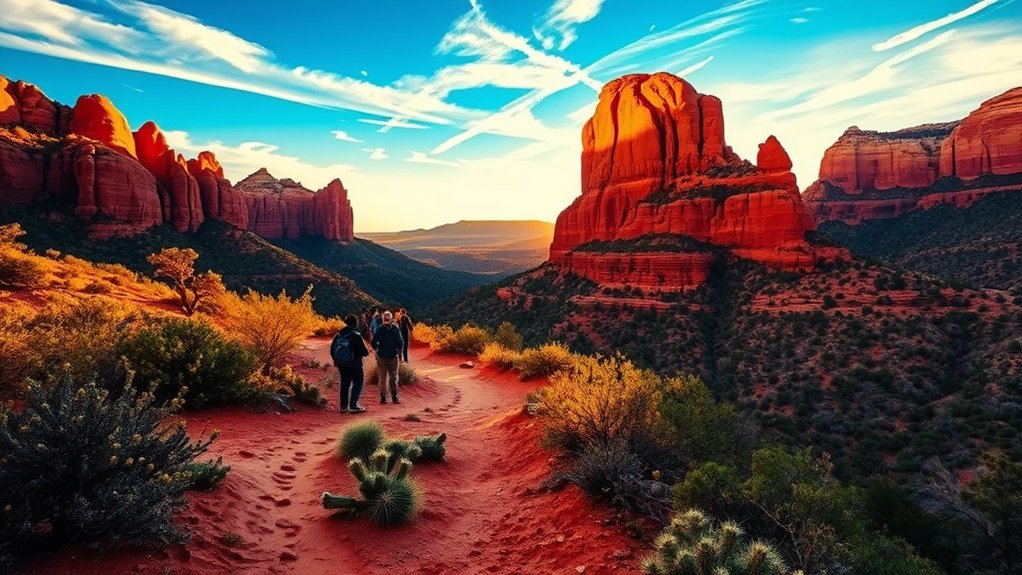
If Cathedral Rock got your legs warmed up, head over to Bell Rock for a more welcoming climb and sweeping panoramic views. You’ll find wide, well-marked trails that suit hikers of varying ability, from easy loops at the base to steeper scrambles toward the bell-shaped formation. As you ascend, red sandstone glows in the morning light and juniper scents ride the breeze. Look for cairns marking optional routes; they lead to small viewpoints where you can pause, catch your breath, and take in vistas of Oak Creek Canyon and distant mesas.
Trail surfaces are firm but uneven—good shoes and sun protection matter. Bring water; shade is limited. If you’re into photography, aim for golden hour when shadows carve the rock’s texture. Bell Rock also attracts bikers and casual walkers, so yield on narrow sections and keep group sizes modest to preserve the quiet. Whether you want a brisk workout or a contemplative stroll, this spot delivers accessible, scenic Arizona red-rock experience.
Visit Chapel of the Holy Cross
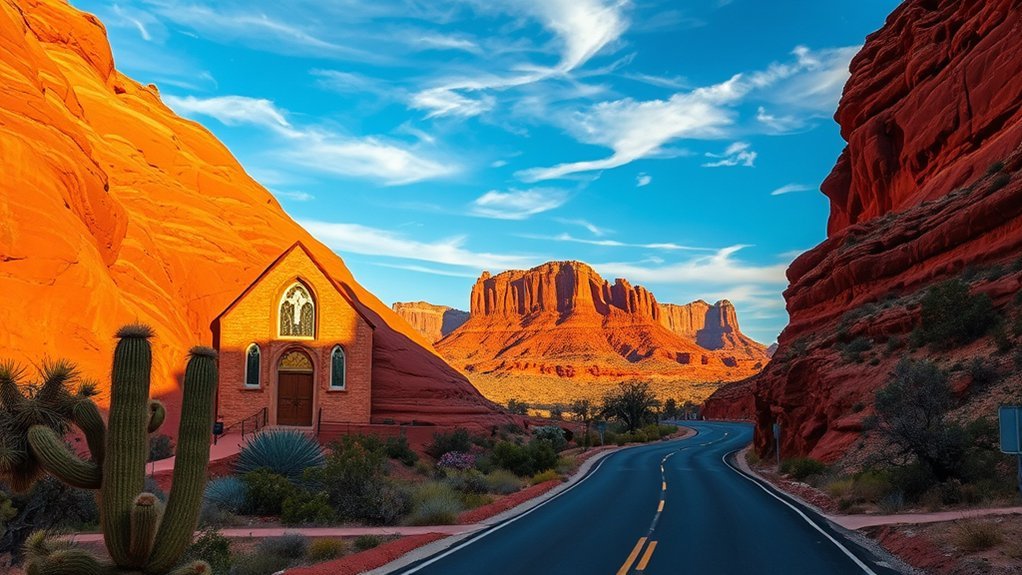
You’ll be struck by the chapel’s dramatic modern architecture carved into the red rock and the story behind its 1950s design. Check posted visiting hours and parking info before you go, since access can be limited during peak times and special services. After your visit, step to nearby viewpoints and short trails for sweeping vistas of Sedona’s mesas and the chapel framed against the skyline.
Architectural Highlights and History
While the red rocks of Sedona draw most eyes, the Chapel of the Holy Cross commands attention with its dramatic, modernist silhouette carved into the sandstone—walk up and you’ll feel how its soaring concrete cross frames panoramic views of the valley. You’ll notice architect Frank Lloyd Wright–inspired lines and sculptural simplicity that contrast the rugged landscape. The chapel’s 1956 completion reflects local patronage, daring engineering, and devotion to site-specific design. Inside, light washes the sanctuary through tall, narrow windows, focusing your gaze on both the altar and the immense red-rock backdrop. Pay attention to materials, proportions, and how the building seems to grow from the stone.
- Modernist design integrated with natural rock
- Engineered foundations on steep sandstone
- Minimalist interior emphasizing light
- Patron-driven commission and community impact
- Landmark status and cultural resonance
Visiting Hours and Access
Although the chapel’s striking presence feels timeless, its doors follow a practical schedule you should plan around: daily hours typically run from midmorning to early evening (often around 9 AM–5 PM), with seasonal shifts and occasional closures for services or special events. When you arrive, check the official website or call ahead — hours change for holidays, private ceremonies, and maintenance. Accessibility is good: there’s ramp access and limited elevator service, but expect some stairs and uneven surfaces nearby. Admission is free, though donations are welcome. Keep in mind quiet reverence is requested inside; photography rules may vary, especially during worship. Arriving early or late in the day helps you avoid crowds and makes parking easier.
Nearby Viewpoints and Trails
Because the Chapel of the Holy Cross sits carved into a towering red-rock ridge, nearby viewpoints and short trails give you dramatic, up-close perspectives of both the chapel and Sedona’s sweeping vistas. You’ll want to linger at the chapel plaza, then pick a favored outlook: each trail reveals different angles of the cross, sheer cliffs, and distant buttes. Wear sturdy shoes, bring water, and plan for light scrambling on some paths.
- Church Trail overlook: quick, paved access with panoramic views.
- Chapel stairs viewpoint: closer, elevated angle of the facade.
- Lava Point Trail: rugged, fewer people, great for sunrise.
- Baldwin Trail connector: shady stretches and rock formations.
- Scenic pullout on Chapel Road: easy stop for photos.
Drive the Red Rock Scenic Byway
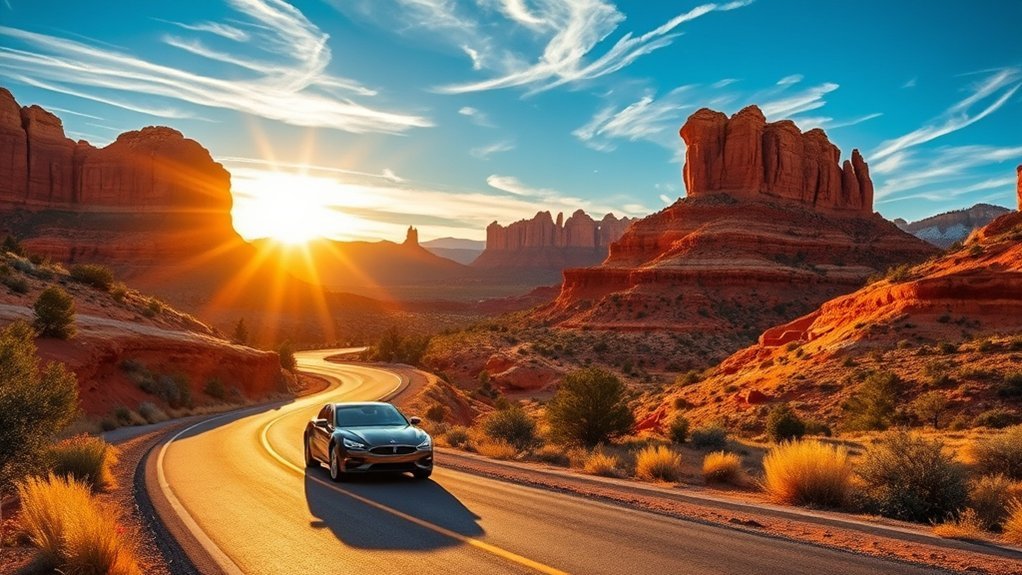
When you drive the Red Rock Scenic Byway, you’ll find a string of scenic overlooks and handy pullouts that let you step out and soak in sweeping views of sandstone spires and canyon light. Plan your trip for early morning or late afternoon when the colors pop and traffic is lighter, or aim for golden hour photos at Oak Creek Vista. Keep an eye on seasonal closures and allow extra time for stops so you can really enjoy each viewpoint.
Scenic Overlooks and Pullouts
Start the Red Rock Scenic Byway with your camera ready and your eyes open: the route is a sequence of dramatic pullouts and overlooks that put Sedona’s sandstone spires, sweeping mesas, and sunlit canyons on full display. You’ll stop at short turnouts to step out, smell pine, and study layered rock textures while light sculpts shadows. Each overlook offers a different frame—close-up fins, distant buttes, river-carved valleys—so you can choose compositions or simply breathe.
- Bell Rock viewpoint: recognizable silhouette, easy access
- Courthouse Butte pullout: broad views, picnic-friendly
- Chapel lookout: iconic framing for sunset photos
- Oak Creek vista: green ribbon below red walls
- Soldier Pass spur: quieter, rugged perspective
Use binoculars, wide and tele lenses, and respect safety barriers.
Best Times to Drive
If you want the most dramatic light and the fewest cars, plan your drive for early morning or late afternoon—sunrise and the golden hour before sunset paint the red rocks in warm, glowing tones and carve deep, photogenic shadows. You’ll catch cooler temperatures, quieter pullouts, and wildlife stirring along Oak Creek. Midday is bright but flat; use it for longer stops or shaded trails. Weekdays cut traffic; weekends fill quickly, especially in spring and fall. Watch for sudden weather changes in monsoon season—storms add drama but reduce visibility. Bring water, a camera, and patience to pull over safely. Use designated overlooks to avoid blocking lanes and respect local speed limits for the best, safest experience.
| Time of Day | Why Go |
|---|---|
| Sunrise | Soft light, few cars |
| Midday | Longer stops, shaded trails |
| Golden Hour | Rich colors, photogenic shadows |
| Night | Stargazing, cooler temps |
Watch a Sedona Sunset From Airport Mesa
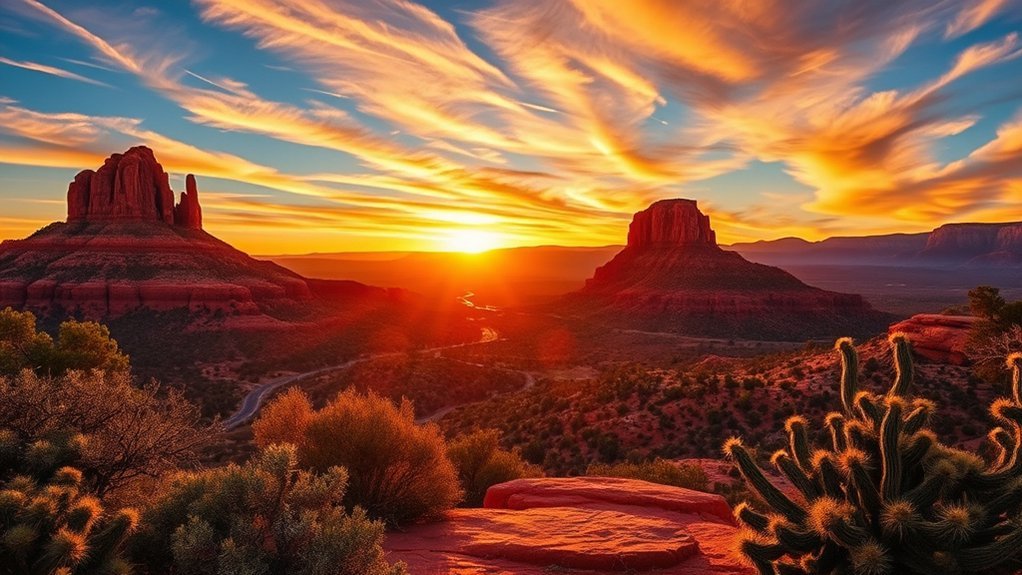
Often as crowds gather, you’ll find Airport Mesa rewarding you with a panorama that shifts from golden to molten pink in minutes — and it’s one of the easiest sunset viewpoints in Sedona to reach. You can walk a short loop trail, claim a rock, and watch light carve the red rocks while the town below softens. The wind carries a dry, warm scent; the sky deepens quickly, so arrive early to pick your spot.
- Best time: 30–45 minutes before sunset for changing colors.
- Access: small parking lot; expect a short walk and moderate crowds.
- Photography tips: use a wide lens and bracket exposures for highlights and shadows.
- Safety: bring water, a jacket for cooling temps, and stay on marked paths.
- Vibe: communal but peaceful—locals and visitors share quiet awe.
When twilight arrives, the rocks glow, shadows stretch, and you’ll feel why this mesa is beloved.
Take a Pink Jeep Tour
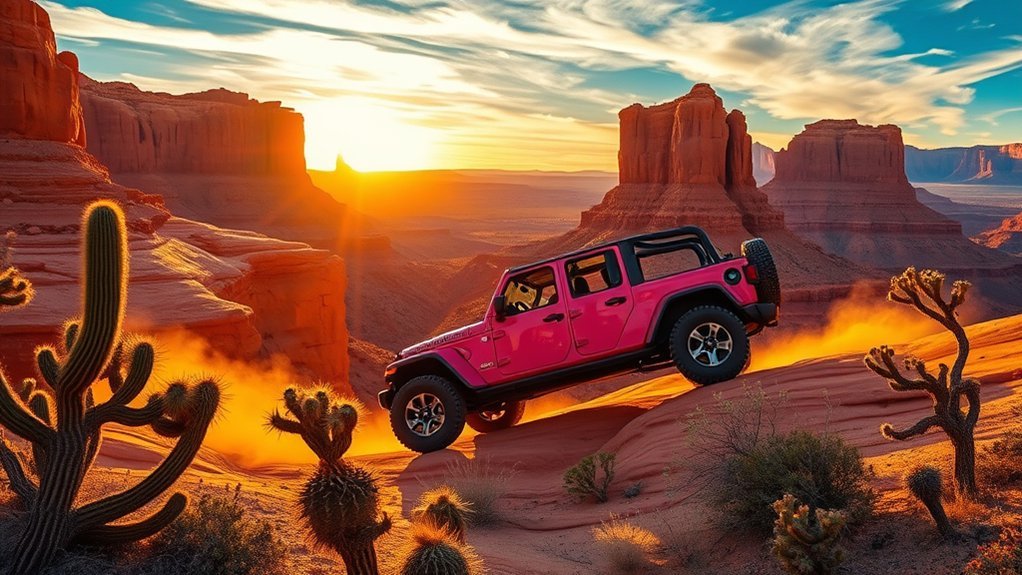
Hop into a Pink Jeep and you’ll feel the landscape rearrange itself as your guide navigates narrow, rocky tracks that reveal Sedona’s hidden cliffs, viewpoints, and slot canyons. You’ll sit high above the terrain, wind in your hair, watching layered red rocks shift color with the sun. Guides point out geological formations, local flora and fauna, and Native American history, weaving facts into the ride so you understand what you’re seeing. Routes vary from gentle scenic drives to rugged four-wheel adventures; choose based on comfort and motion tolerance. Wear closed shoes, sunscreen, and layers—temperatures change quickly. Bring a camera with fast shutter speed for crisp photos on bumpy trails. Tours often include short hikes and photo stops but avoid steep or technical scrambling unless it’s listed. Vehicles are well maintained and guides prioritize safety while keeping the pace lively. A Pink Jeep tour is an efficient, memorable way to access remote vistas you’d likely miss on your own.
Walk the Devil’s Bridge Trail
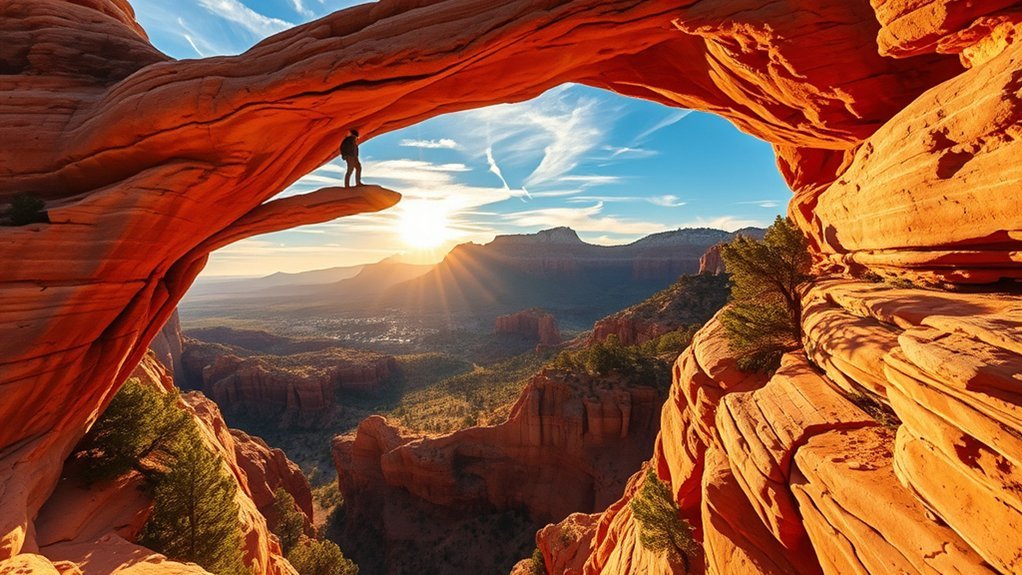
Trek the Devil’s Bridge Trail and you’ll find one of Sedona’s most iconic natural arches waiting at the end of a moderately steep, rocky path—perfect for a morning hike when the light brings the red rock alive. You’ll climb switchbacks, hop over slick sandstone, and feel the canyon air sharpen your focus as the arch looms into view. Once there, step onto the bridge carefully; the view down Oak Creek and across layered buttes rewards the effort.
- Trail length: about 4.2 miles round-trip from the trailhead.
- Difficulty: moderate; expect rocky sections and some exposure.
- Best time: sunrise or early morning to avoid heat and crowds.
- Safety: wear sturdy shoes, bring water, and watch footing on the arch.
- Photography: wide-angle lens or panoramic shots capture the sweeping vistas.
You’ll leave with a visceral sense of scale and a clear memory of Sedona’s raw, sculpted beauty.
Stroll Tlaquepaque Arts & Shopping Village
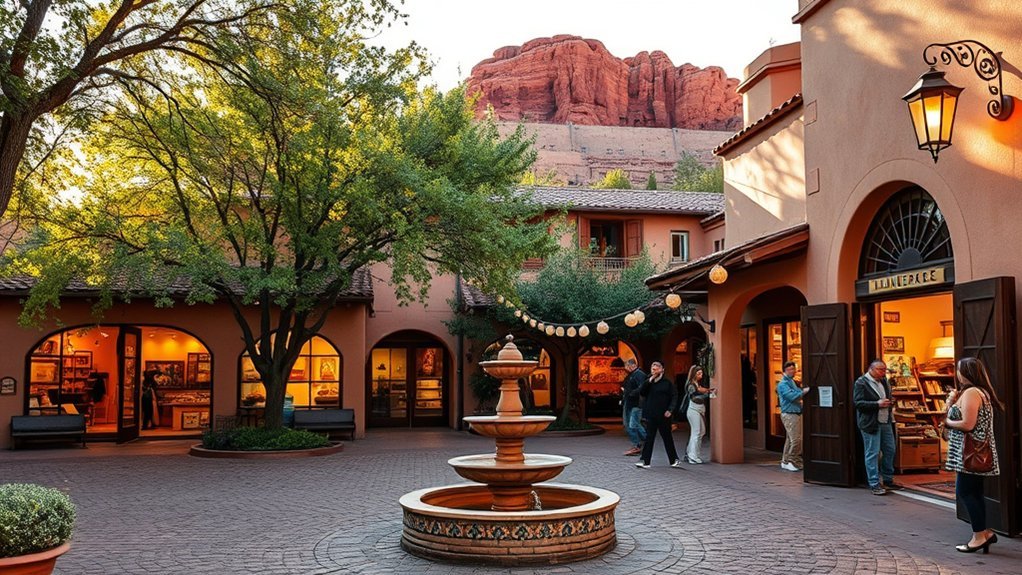
Wander through Tlaquepaque Arts & Shopping Village and you’ll feel like you’ve stepped into a living gallery—clay-tiled courtyards, vine-draped archways, and bubbling fountains set the scene for dozens of galleries, boutiques, and artisan studios. You’ll browse handcrafted jewelry, blown glass, and Southwestern pottery while local artists often work in plain view, so you can watch techniques and ask about materials. Stop at a gallery to see contemporary prints or traditional Native American pieces, and check placards for provenance and artist statements. Light filters through courtyards in the afternoon, making it an ideal time for photos and relaxed window-shopping. Cafés and wine bars let you pause between shops; try a light bite on a shaded patio. The Village hosts seasonal events and live music, so glance at the schedule to catch openings or demonstrations. Practical tip: street parking fills fast—arrive early or use local shuttles to maximize your time exploring every tucked-away studio.
Experience a Vortex Site
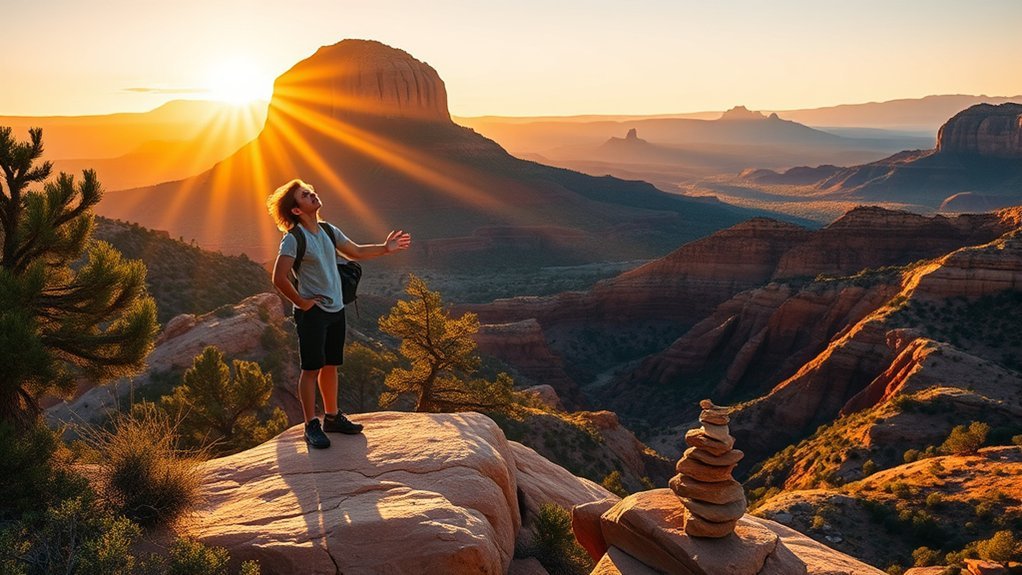
A vortex in Sedona is said to be a spot where the earth’s energy feels more concentrated, drawing people for reflection, healing, or a quiet sense of clarity. Popular vortex locations include Airport Mesa, Bell Rock, Cathedral Rock, and Boynton Canyon, each offering different terrain and vibes to explore. When you visit, pause, breathe deeply, and notice subtle shifts—tingling, warmth, or a calming stillness—as signs you’re tuning into the local energy.
What Is a Vortex
Curious what people mean when they call Sedona a “vortex”? You’ll feel it more than define it: a concentrated natural spot where energy, solitude, and landscape converge. Visitors report heightened clarity, calm, or emotional release as they stand among red rocks and open sky. A vortex isn’t magic—it’s a mix of geology, light, wind patterns, and your own expectations that shapes an intense, personal experience.
- You might notice a sudden sense of peace or focus.
- Physical sensations—tingling, warmth, or light-headedness—aren’t uncommon.
- Many use the feeling for meditation, reflection, or creative insight.
- Scientific explanations focus on geology and microclimates.
- Personal meaning varies; your experience will be unique.
Best Vortex Locations
If you felt something at a vortex in Sedona, you’ll want to know where others go to find that same concentrated stillness. Oak Creek Canyon and Cathedral Rock are top picks: Oak Creek’s shaded banks and rushing water offer a gentle, grounding vibe, while Cathedral’s sandstone amphitheater focuses energy in a dramatic, contemplative bowl. Bell Rock is accessible and stable, with broad ledges suited to quiet reflection or short guided sits. Boynton Canyon combines red rock walls with a sheltered, intimate trail that many describe as balanced and restorative. Slide Rock and Airport Mesa attract visitors for different reasons—water and panoramic views—so plan timing: early mornings are quieter. Respect signage, stay on trails, and bring water and a mindful presence.
How to Feel Energy
Sitting quietly at a vortex lets you notice subtle shifts in breath, temperature, and thought—so begin by arriving with intention and slowing your pace. You’ll ground yourself by tuning senses: feel the rock beneath you, listen to wind through juniper, and watch light shift across red stone. Expect subtle physical sensations—tingling, warmth, or a calm heaviness—and mental changes like clarity or emotional release. Use simple practices to enhance awareness:
- Stand barefoot briefly to feel earth’s coolness and connection.
- Close your eyes and count inhales and exhales for five minutes.
- Hold palms open above a rock to sense temperature differences.
- Walk slowly, noticing each footfall and breath.
- Sit facing the sun and note any shifts in mood or focus.
Honor what you experience without forcing outcomes.
Hike West Fork Trail
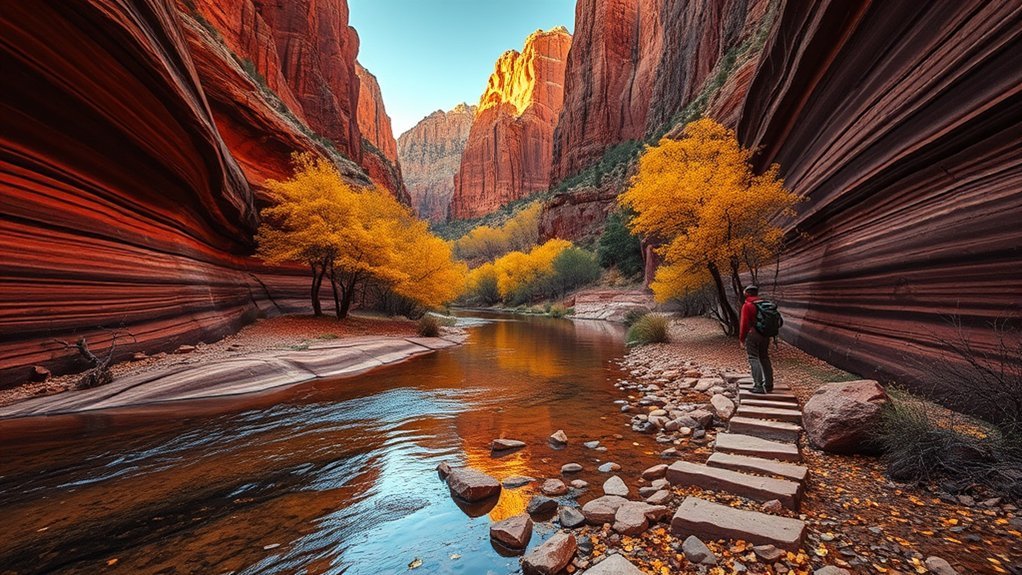
Winding through a narrow canyon carpeted with sycamores and ferns, the West Fork Trail gives you an intimate, cool contrast to Sedona’s red-rock panoramas; you’ll cross the creek up to a dozen times, pick your footing on smooth stones, and find sunlight slicing through the cliffs in golden shafts. You’ll move at your own pace—wading shallow water, stepping over root tangles, pausing where moss blankets the banks. Early morning brings bird song and cooler air; autumn paints the sycamores in vivid gold. The trail’s gentle grade and clear path make it great for fit beginners and seasoned hikers who want a relaxed, scenic outing.
| Feature | What to Expect |
|---|---|
| Distance | About 6.8 miles round trip |
| Difficulty | Easy to moderate; frequent creek crossings |
| Best Times | Fall, spring, early morning |
Bring water, quick-dry socks, and waterproof shoes; watch for slippery rocks and leave no trace.
Enjoy Red Rock State Park
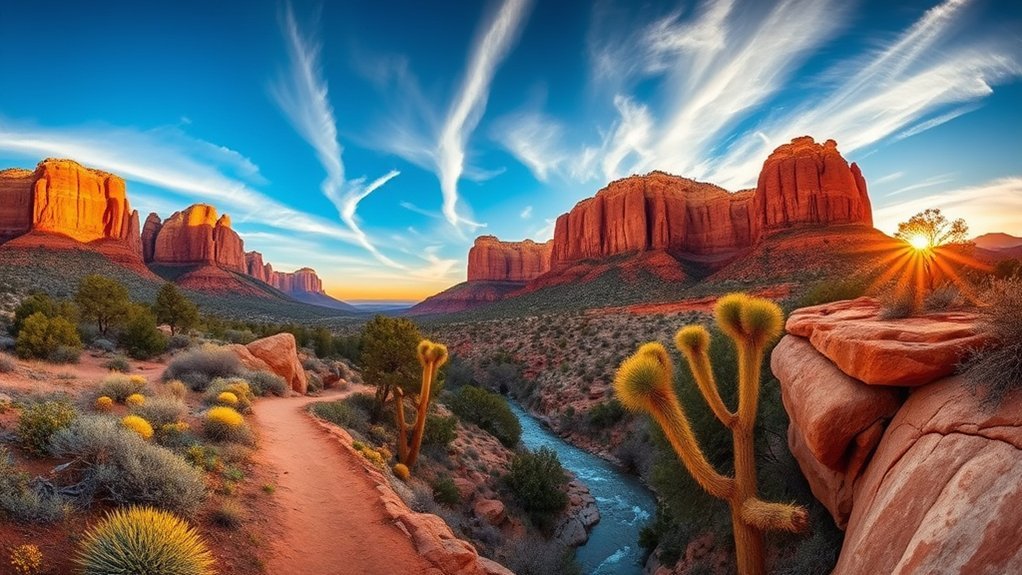
At Red Rock State Park you’ll find well-marked hiking trails that wind through red sandstone formations and fragrant juniper flats. Keep your binoculars handy for spotting coyotes, rabbits, and a rich variety of birds along the creek corridors. Pack a picnic and claim a scenic overlook for sunset views that make a perfect break between hikes.
Best Hiking Trails
Set out into Red Rock State Park and you’ll immediately feel why its trails are a must for anyone visiting Sedona: red sandstone formations rise like sculptures, scrub oak and juniper scent the air, and every path frames a different sunlit vista. You’ll find trails for quick viewpoints and full-day treks, all well-marked and maintained. Bring water, sturdy shoes, and sun protection; trails climb slickrock and cross shaded canyons. Expect panoramic overlooks, natural amphitheaters, and switchbacks that reward you with sweeping valley views. Choose a route that matches your fitness and time.
- Crescent Moon: easy riverside stroll, great for sunset
- Eagle’s Nest: short climb, dramatic lookout
- Wilson Mountain: strenuous, highest views
- Lee Mountain: moderate, varied terrain
- Mescal Trail: quiet, scenic ridgeline
Wildlife & Birdwatching
Often you’ll spot wildlife right from the trail—mule deer grazing in the morning light, rock squirrels darting among the boulders, and coyotes slipping along wash edges—so move quietly and keep your distance to avoid startling them. At Red Rock State Park, you’ll find a concentrated mix of habitats: riparian corridors with willows and cottonwoods, juniper-pinyon slopes, and rocky outcrops that attract varied species. Bring binoculars and a field guide to pick out red-tailed hawks, white-winged doves, and occasional peregrine falcons; early mornings and dusk are prime viewing times. Listen for canyon wren songs echoing off the rocks. Stay on marked paths, avoid feeding animals, and record sightings—your notes help local conservation efforts and deepen your connection to Sedona’s wild side.
Picnic Spots & Views
While you’re watching for wildlife, don’t miss the many picture-perfect picnic nooks scattered through Red Rock State Park. You’ll find mesas, shaded cottonwood groves, and plateau edges that frame cathedral red rocks, so pack a blanket and a simple meal. Settle in where wind-carved formations meet open sky, watch light shift across sandstone, and listen to distant creek chatter. Bring water, sun protection, and leave no trace.
- West Fork overlook: cool shade, stream sounds
- Crescent Moon picnic area: river access, sunset views
- Soldier Pass edge: panoramic red-rock vistas
- Butterfly Trail bench: quiet, bird activity
- Grasslands mesa: wide-open sky, ideal for stargazing
Visit Slide Rock State Park
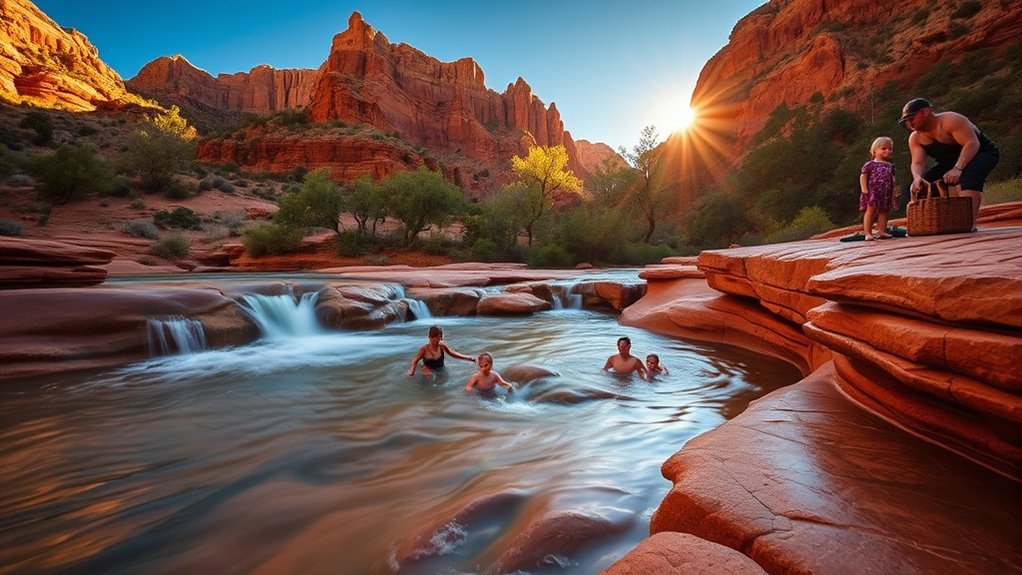
Slide Rock State Park feels like stepping into a natural waterpark carved from red sandstone—you can slide down smooth, shallow chutes into clear Oak Creek, lounge on warm rocks, or picnic under cottonwoods while watching kids laugh and splash. You’ll follow worn stone paths to cool pools where current and gravity meet; the slide’s polish is centuries of water-smoothed rock, not manufactured fun. Bring water shoes, a towel, and a small dry bag for keys and phone. Park early in summer; the lot fills fast and rangers enforce capacity. Trails around the creek are short and scenic, perfect for stretching your legs between swims. Photo opportunities are everywhere—close-ups of rippling water, wide shots of red cliffs, and candid family joy. Respect posted rules, stay within lifeguarded areas, and watch for slippery spots. After a few slides and a shaded picnic, you’ll leave with sand between your toes and a fresh, cool buzz.
| Feature | Impression |
|---|---|
| Natural slides | Smooth, fast fun |
| Pools | Cool, clear respite |
| Cottonwoods | Shaded picnic spots |
| Cliffs | Dramatic red backdrop |
Explore Oak Creek Canyon
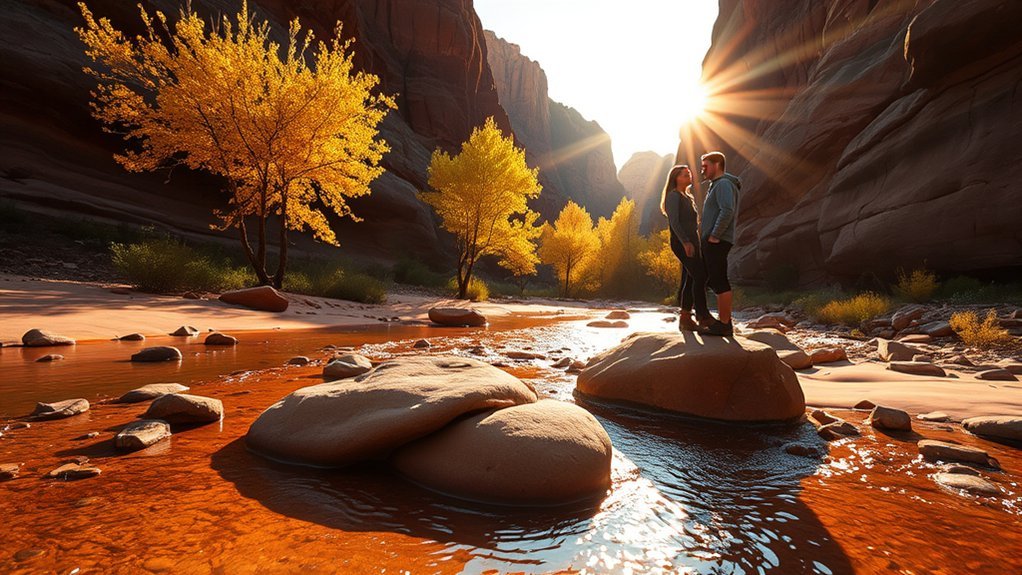
Drive the scenic switchbacks of Oak Creek Canyon and you’ll be treated to towering red walls and sweeping creekside views that change with every turn. Park and follow well-marked trails that hug the water for easy hikes and quiet swimming holes. Pack a lunch—there are plenty of shaded picnic spots where you can rest and listen to the creek.
Scenic Drive Views
Take the scenic Oak Creek Canyon Road and you’ll feel the landscape open up—towering red-rock cliffs, shaded pine corridors, and foamy creek sections that invite frequent stops. You’ll drive slowly, window down, watching light shift on sandstone walls while pullouts tempt you to photograph layered vistas. Scenic signs point out geology and viewpoints; you’ll note elevation changes as aspens and oaks replace desert scrub. Expect changing temperatures and shade; pack water and a light jacket. The road itself is part of the experience, with tight curves that reward patience and attention.
- Stop at designated overlooks for broad canyon panoramas.
- Use pullouts to take long-lens photos of rock textures.
- Time your drive for golden hour light.
- Check seasonal foliage for color changes.
- Respect wildlife and stay on paved areas.
Creekside Hiking Trails
Winding along Oak Creek’s shaded banks, these trails put you up close to the canyon’s coolest, most tranquil moments—riffles and pools glitter between red-rock walls, cottonwoods rustle above narrow footpaths, and ferns cling to mossy ledges where sunlight slips through. You’ll follow well-marked routes like the West Fork and Crescent Moon, where creekside footing alternates between packed dirt, exposed roots, and stepping-stones. Bring sturdy shoes and a light daypack; water, snacks, and a map matter because side canyons and creek crossings can slow your pace. Watch for wildlife—kingfishers, mule deer—and seasonal wildflowers tucked in shady pockets. Early mornings and late afternoons offer softer light for photography and cooler air for longer hikes, while trail etiquette keeps the canyon peaceful for everyone.
Swimming & Picnic Spots
Along Oak Creek’s cool margins you’ll find perfect pockets for swimming and picnicking where red-rock cliffs lean over clear, waist- to shoulder‑deep pools and shady cottonwood groves. You’ll step onto smooth rocks, feel cold water at your calves, and scout flat spots for laying a blanket. Popular areas like Slide Rock draw swimmers; quieter coves let you read or snorkel among minnows. Bring water shoes, a sun hat, and a picnic that won’t leave trash. Respect posted rules and fragile riparian vegetation so others enjoy the same scene.
- Slide Rock: natural waterslide, busy in summer
- Crescent Moon Picnic Area: roomy shade, river access
- Grasshopper Point: calmer pools, good for families
- Midgley Bridge: scenic overlooks and wading spots
- Secret side-canyons: for quiet swimming and reflection
Take a Hot Air Balloon Ride
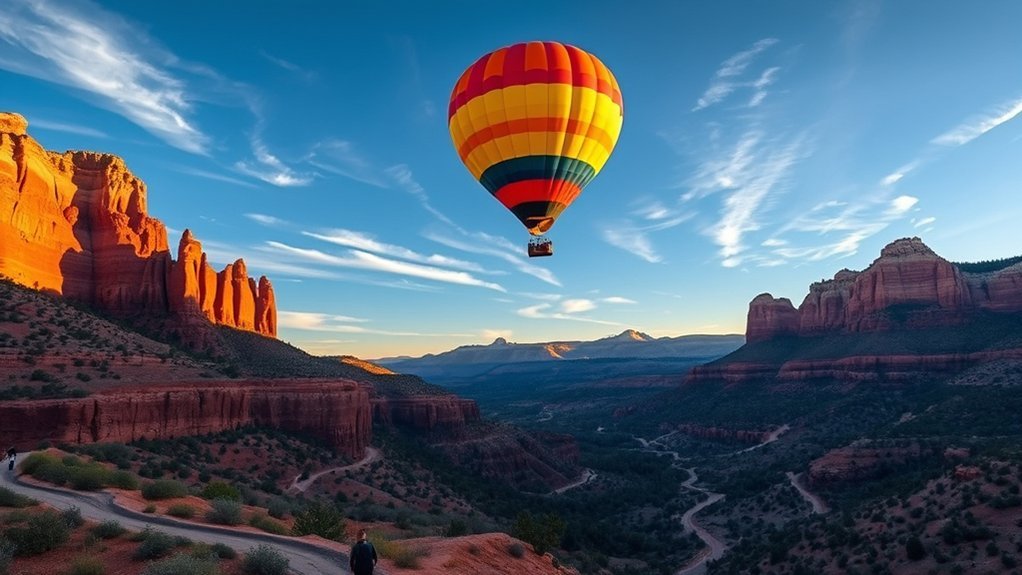
Often at sunrise you’ll rise above Sedona’s red-rock labyrinth in a gently swaying hot air balloon, watching the valley’s colors deepen as the sun warms the sandstone. You lift off from a quiet field as pilots run final checks and burners hiss, and the world below unfolds—rust-colored spires, winding washes, and tiny cars along scenic roads. The ride lasts about an hour; operators brief you on safety, ideal clothing, and landing posture. Expect calm, panoramic views and photo opportunities that ground tours can’t match. Mornings are preferred for stable air and dramatic light, so plan an early start and book in advance, especially during peak seasons. Choose licensed companies with experienced pilots, clear cancellation policies, and small passenger loads if you value intimacy. After touchdown, flights often end with a short celebration and certificates. A balloon trip turns Sedona’s geology into a slow, silent theater—memorable, peaceful, and utterly different from hiking the same red rocks.
Tour Local Art Galleries
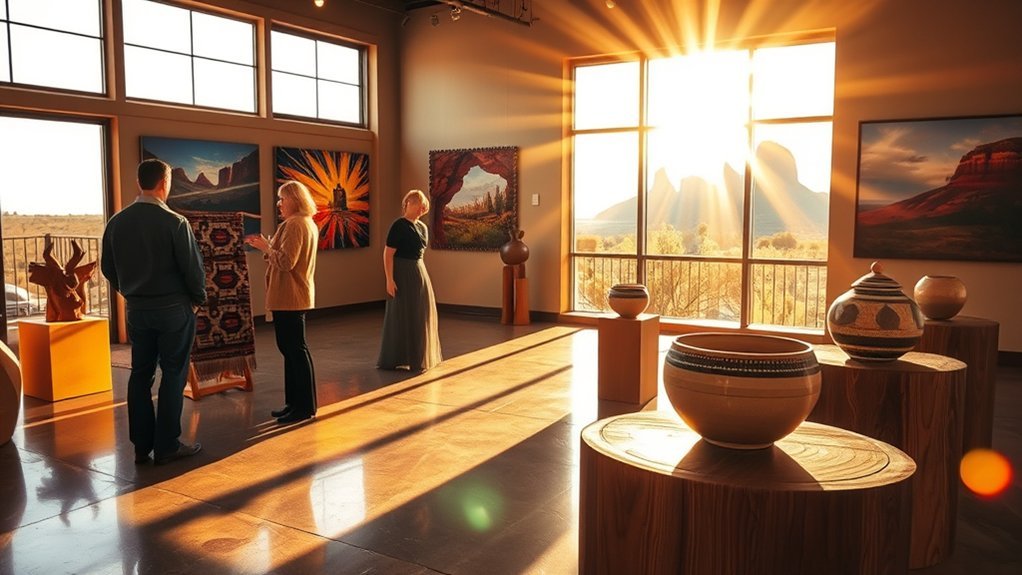
Step into Sedona’s galleries and you’ll find a vibrant conversation between landscape and hand—paintings, sculptures, jewelry, and mixed-media pieces that echo the region’s colors, textures, and spiritual energy. You’ll wander intimate spaces where light slants across canvases of red rock and turquoise glass, and gallery owners will happily point out local techniques and artist backstories. Take time to touch the emotional thread in each piece and ask about materials, provenance, and whether works are original or limited editions. Look for artist demonstrations, rotating exhibits, and cooperative galleries showcasing emerging talent.
- Seek galleries near Tlaquepaque Arts & Crafts Village for variety
- Ask about artist meet-and-greets and opening receptions
- Note traditional stone and silver jewelry reflecting Indigenous influence
- Photograph installations where permitted to remember details
- Purchase smaller works or prints as portable mementos
You’ll leave with deeper insight into Sedona’s creative pulse and a meaningful keepsake.
Sample Wines at Verde Valley Wineries
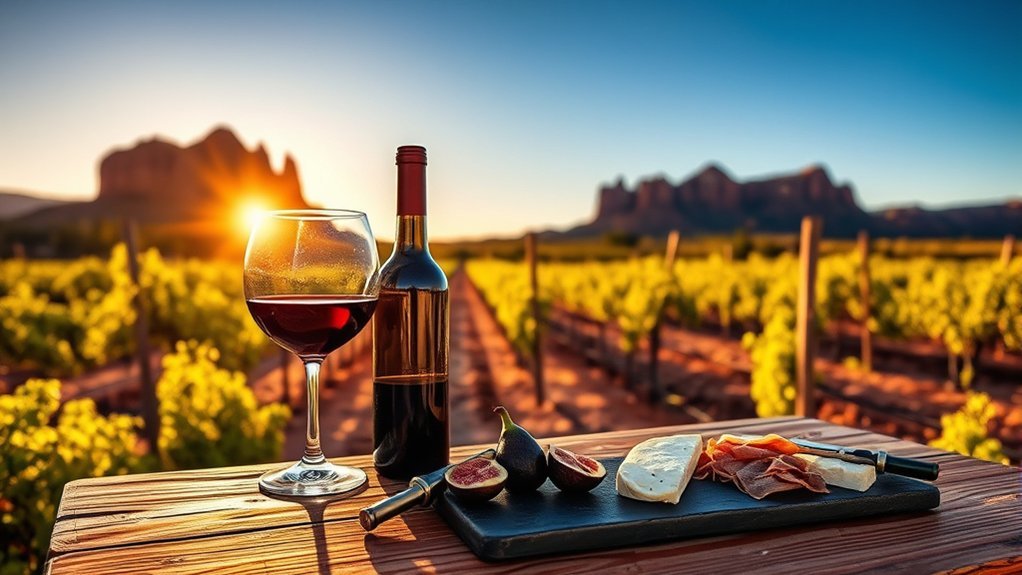
You’ll find Verde Valley wineries nestled among juniper-dotted hills and vineyards that soak up Arizona sun, where tasting rooms invite you to sip crisp whites, bold reds, and unexpected varietals grown at altitude. You’ll stroll from rustic tasting rooms to modern patios, sampling Verde Blanc, Petite Sirah, and dry rosés while hosts explain how high desert soils and large diurnal swings shape flavor. Ask for flights to compare oak-aged and unoaked styles, and note tannin, acidity, and fruit intensity. Many wineries pair pours with local cheeses, charcuterie, or chocolate — a quick pairing can teach you balance and finish. Plan visits in cooler morning or late afternoon light; vineyards look best then and heat’s less intrusive. If you want a deeper look, book a tour to see vine rows, fermentation tanks, and barrel rooms, where you’ll learn harvest timing and oak influence. Support small producers by buying a bottle or joining a club to extend the Verde Valley experience at home.
Enjoy a Spa or Wellness Treatment
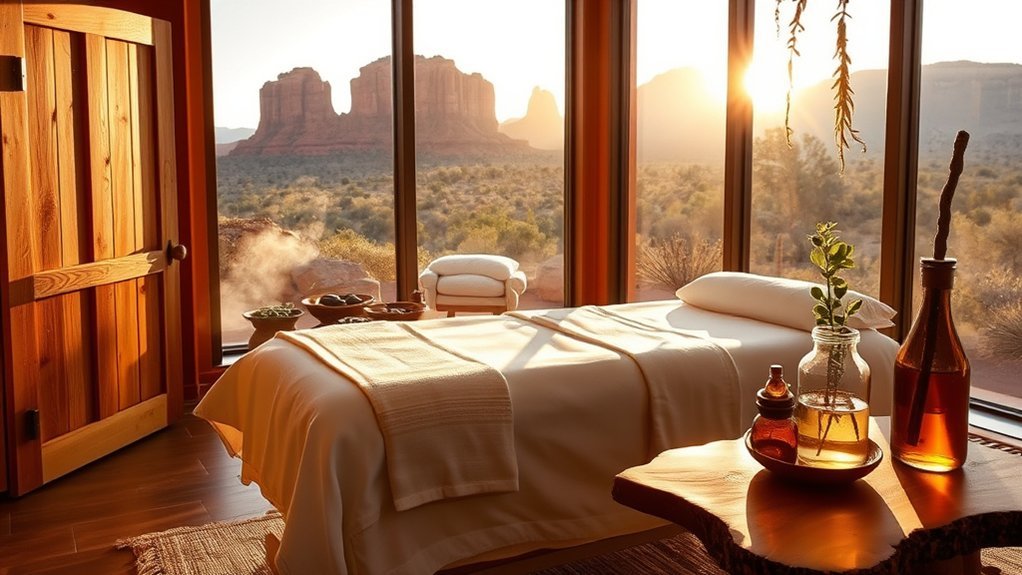
Treat yourself to a restorative spa day at one of Sedona’s luxury resorts, where you can enjoy signature massages, mineral baths, and upscale amenities that melt away travel fatigue. Book a vortex healing session to experience guided energy work amid the red rocks, or choose an outdoor massage so you can breathe fresh desert air while a therapist works tension from your muscles. Whether you want full-service pampering or a nature-infused treatment, you’ll find options that balance relaxation and renewal.
Luxury Spa Resorts
Often you’ll find that a day at a Sedona luxury spa feels like an intentional pause: warm desert sun, quiet red-rock views, and skilled therapists who blend local healing traditions with modern treatments. You step into serene lobbies, inhale juniper and citrus scents, and let guided rituals reset your body and mind. Treatments range from deep-tissue massages to mineral-rich wraps, each tailored to your needs. Expect attentive service, restorative pools, and outdoor relaxation terraces that showcase the landscape.
- Signature massages using native botanicals
- Hydrotherapy circuits and mineral soaks
- Personalized wellness plans and private suites
- Outdoor treatment cabanas with canyon vistas
- Post-treatment lounges with herbal teas and light bites
Choose a resort that aligns with your pace and intentions.
Vortex Healing Sessions
Frequently, visitors find Sedona’s vortex healing sessions feel like a recalibration for body and mind, blending guided meditation, gentle energy work, and hands-on therapies set against those iconic red-rock backdrops. You’ll sit or move slowly while a practitioner helps you tune into the local energy—some people notice warmth, tingling, or a deep sense of release. Sessions often combine breathwork, visualization, chakra balancing, and sound healing to clear tension and sharpen awareness. Expect a brief intake to set intentions, then focused exercises tailored to stress, grief, or creative blocks. Wear comfortable clothes and bring an open mind; results vary, from subtle shifts to profound clarity. Book with reputable guides who explain methods, contraindications, and aftercare for best outcomes.
Outdoor Massage Options
Framed by rust-colored cliffs and open sky, an outdoor massage in Sedona turns a routine treatment into a sensory ritual—feel the sun’s warmth on your skin, hear distant wind through junipers, and breathe the desert’s dry, aromatic air as a therapist works tension away. You’ll choose from treatments that blend Swedish, deep-tissue, or hot-stone techniques with panoramic views, often at boutique spas, retreat centers, or private Ranch settings. Expect quiet privacy, biodegradable oils, and therapists trained to read the body’s response to heat and altitude. Bring layered clothing and sun protection; sessions can be scheduled at sunrise or golden hour for softer light and cooler temperatures.
- Sunrise restorative sessions
- Hot-stone sessions on heated pads
- Couples massages in private alcoves
- Mobile therapists for villas
- Integrative aromatherapy blends
Attend a Sound Bath or Meditation Session
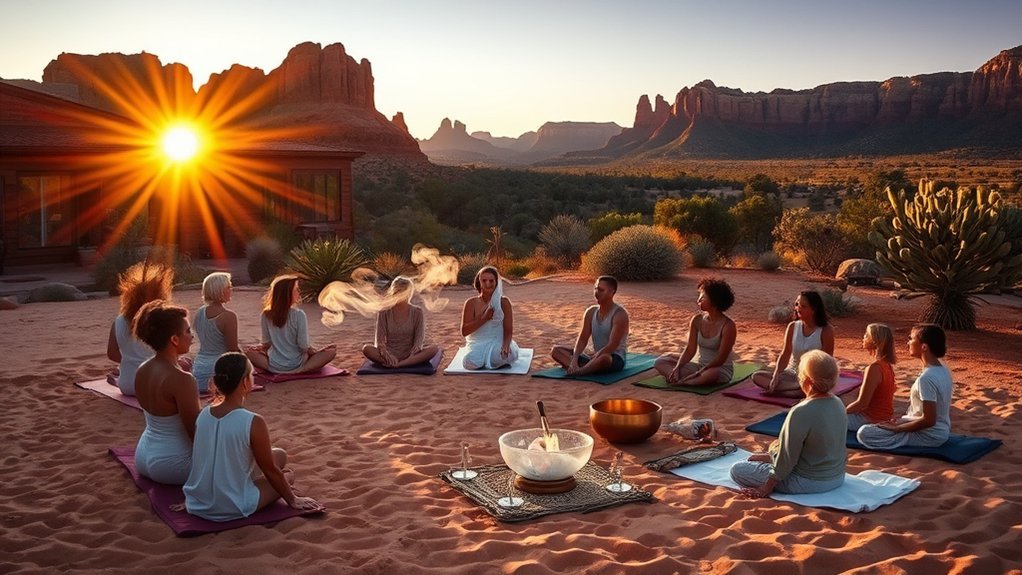
Slipping into a dimmed studio for a sound bath or guided meditation in Sedona, you’ll feel the desert’s hush settle into your body as crystal bowls, gongs, and guided breathwork lead you toward deep relaxation. You’ll lie on a mat or sit comfortably while a facilitator layers resonant tones to shift brainwaves from alert to restorative states. Sessions vary: some emphasize vibrational healing with tuned crystal bowls, others combine chanting, breath cues, or short visualizations tied to the red-rock landscape. Expect clear instructions about posture, intention, and safety—especially if you’re pregnant or sensitive to sound—and bring an eye mask and light blanket. Many studios offer drop-in classes, private sessions, and occasional workshops that teach self-practice techniques. Afterward, you’ll likely notice softened tension, clearer thoughts, and a slowed pace that makes it easier to connect with Sedona’s calmer rhythms. Book ahead for popular times, and arrive early to settle in without disrupting the group.
Explore Amitabha Stupa & Peace Park
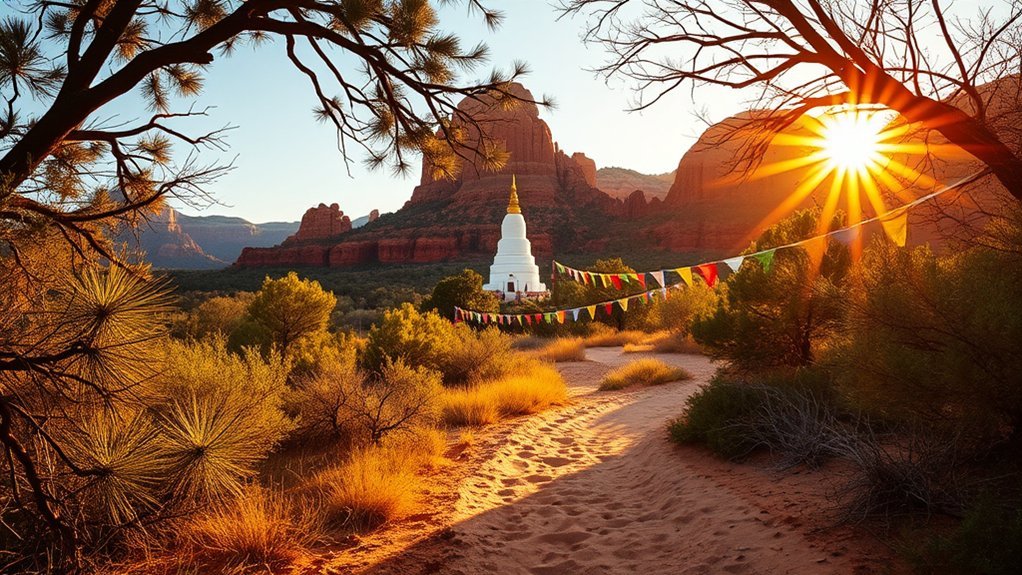
Tucked into a quiet red-rock enclave, the Amitabha Stupa & Peace Park offers a calm, contemplative contrast to Sedona’s popular trailheads—you’ll find a white Tibetan stupa, prayer wheels, and winding paths that invite slow, reflective walking. You’ll feel the place’s gentle hush as soon as you step through the gate; light plays across sandstone while the stupa’s white surface seems almost luminous. Move deliberately around the circular paths, stopping at benches or tucked viewpoints to breathe and take in the vistas. The park’s design encourages respectful silence, so you’ll likely share the space with meditating visitors and quietly turning prayer wheels.
- Sit on a bench and watch clouds drift over red spires.
- Spin prayer wheels clockwise for traditional merit-making.
- Walk the stupa’s circumambulation path mindfully.
- Note plaques explaining Buddhist symbolism and park history.
- Visit at sunrise or late afternoon for softer light and fewer people.
You’ll leave feeling grounded and centered, refreshed by the park’s serene contrast to Sedona’s bustle.
Go Mountain Biking on Bell Rock Pathway
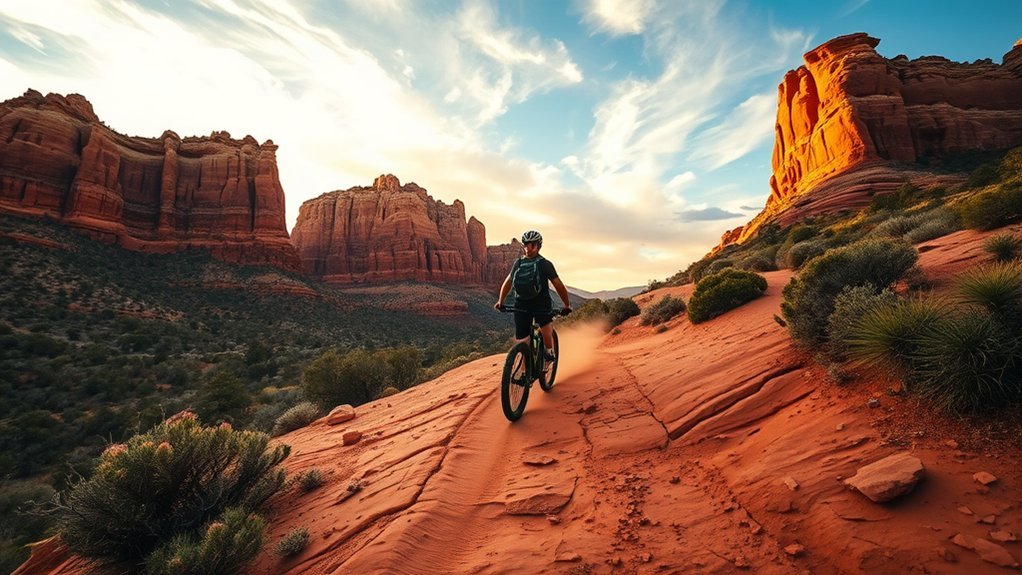
Hitting the Bell Rock Pathway on a mountain bike is an exhilarating way to take in Sedona’s iconic red formations—wide, packed dirt trails and short technical sections make it ideal for riders of varied skill levels. You’ll clip in and roll under soaring cliffs, feeling the sun on sandstone as switchbacks and gentle rollers test your rhythm. The main loop is forgiving but offers optional singletrack spurs that reward you with tighter turns and short rock gardens; they’re perfect for practicing line choice and balance. Keep your eyes on trail markers, watch for hikers, and manage speed on blind corners. Morning rides deliver cooler air and softer light, while late afternoon casts dramatic shadows across ledges. Pack water, a tube kit, and layers—temperatures swing quickly. If you want guidance, local outfitters rent bikes and suggest routes based on conditions. You’ll leave with red dust on your tires and a clearer sense of Sedona’s terrain.
Visit Palatki Heritage Site
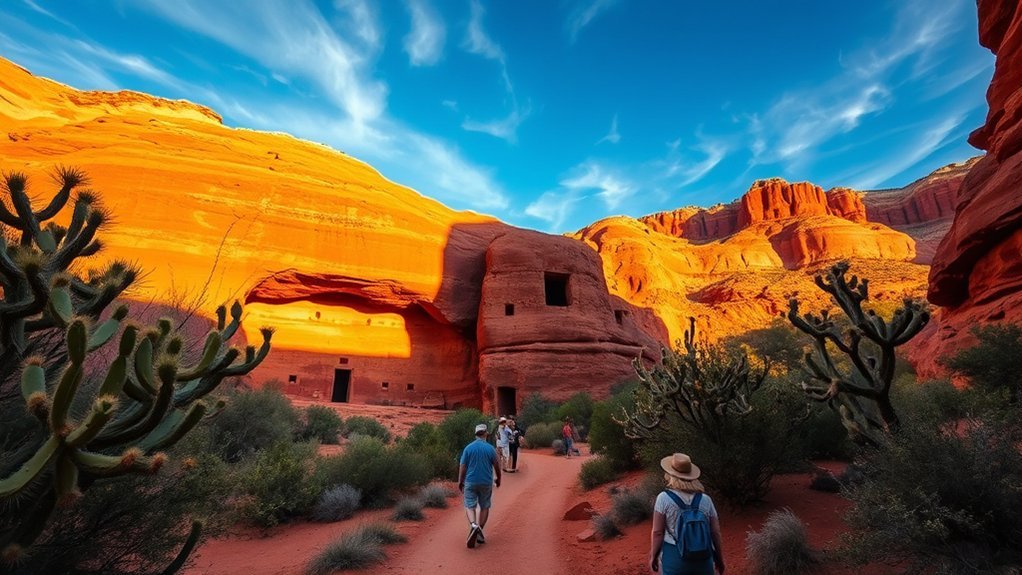
Perched beneath a jutting sandstone overhang, the Palatki Heritage Site lets you step directly into ancient Sinagua life—rock-art panels and cliff dwellings that date back centuries feel immediate and human up close. You’ll follow a short, shaded trail to guided-viewing areas where petroglyphs and pictographs reveal stories, hunting scenes, and celestial symbols. The guide explains techniques and cultural context, so the imagery means more than shapes on stone. You’ll sense the scale of daily life from masonry remains and storage rooms tucked into alcoves, imagining families, food storage, and seasonal rhythms.
Perched under a sandstone overhang, Palatki’s cliff dwellings and rock art bring ancient Sinagua life vividly close.
- Bring water and sun protection; desert weather shifts fast.
- Wear sturdy shoes; trails are rocky and sometimes uneven.
- Respect barriers; fragile art can’t be touched.
- Check the visitor center for tour times and fees.
- Combine with short hikes nearby to maximize the visit.
You’ll leave with a clearer sense of continuity between past inhabitants and the red-rock landscape you’re exploring.
Explore Honanki Heritage Site
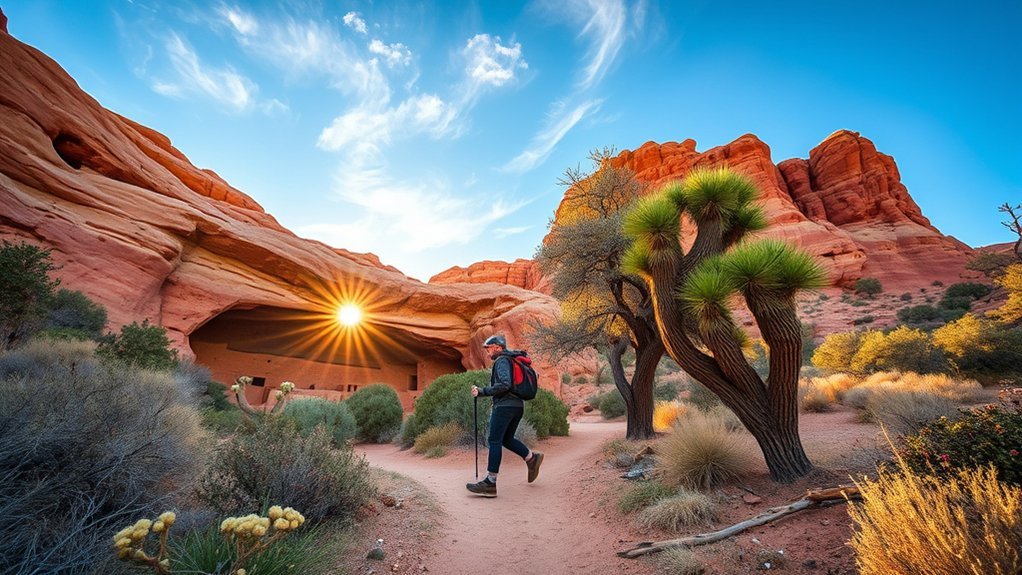
If Palatki gave you a window into Sinagua life, Honanki opens a louder, more dramatic chapter: cliff-face galleries covered in bold pictographs and the remains of larger masonry pueblos that sit beneath a soaring alcove. You’ll approach on a short trail that winds through juniper and manzanita, then step into a cool shadowed hollow where panels of red, black and white figures confront you. Look closely: anthropomorphs, spirals and handprints tell stories of ceremony, migration and daily life. Interpretive signs help, but let your eyes map the layering—older, faded images beneath fresher strokes—so you sense time’s depth. The pueblo ruins show masonry techniques and room layouts; imagine families storing food and weaving fabrics. Respect the site by staying on paths, not touching the rock art, and following seasonal access rules. A short visit gives you a vivid, compact lesson in Sinagua artistry and community life, grounded in place and geology.
Take a Photography Tour
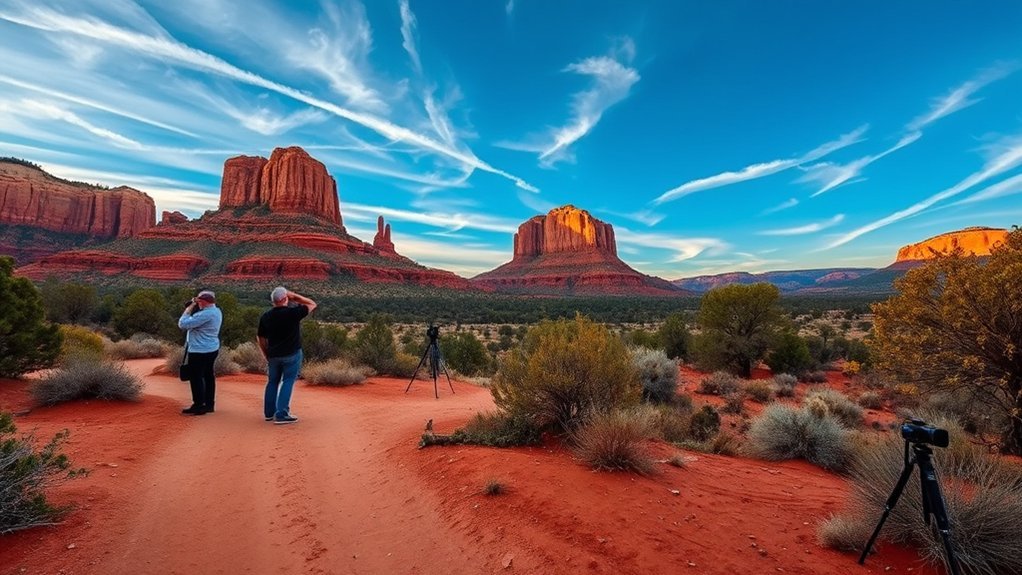
Bring your camera and a sense of curiosity: a photography tour in Sedona turns its dramatic light and sculpted red rocks into a live classroom. You’ll move with golden-hour shifts, learn framing that highlights layered mesas, and practice exposure techniques for high-contrast scenes. Guides point out secret vantage points and coach you on composition, filters, and timing so you capture both grand panoramas and intimate textures.
You’ll come away with stronger technical skills and a deeper eye for natural patterns — ripple marks in sandstone, cactus silhouettes, and sunbeams through junipers. Tours often adapt to your gear and goals, whether you want landscapes, macro details, or astrophotography.
- Sunrise and sunset timing tips
- Recommended lenses and filter use
- Safe, Leave-No-Trace shooting practices
- Composition rules for red-rock landscapes
- How to process RAW files for true-to-scene color
Book a small-group tour for personalized feedback; expect to walk moderate terrain and leave with images that feel like souvenirs and studies.
Dine at Sedona’s Farm-to-Table Restaurants
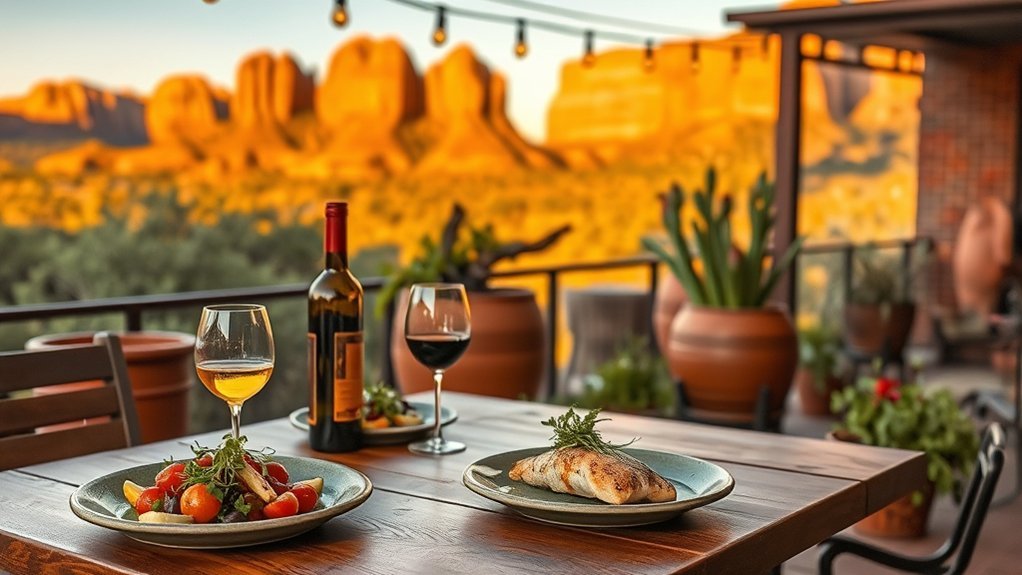
After a morning of framing sunlit buttes, let your next sensory lesson be on the plate: Sedona’s farm-to-table restaurants turn regional bounty into meals that echo the landscape. You’ll find menus that change with the season—heirloom tomatoes and basil in summer, roasted root vegetables and citrus in winter—each ingredient sourced from nearby farms, ranches, and foragers. Expect bright, herb-forward preparations, wood-fired grills, and creative takes on Southwestern staples like green-chile pork or prickly pear desserts. Servers often tell the story behind a producer, so you’ll know where your lamb grazed or which microfarm grew the salad greens. Many venues pair local wines and craft cocktails with menus, emphasizing balance and provenance. Outdoor patios framed by red rocks make dinners feel rooted in place. If you want a memorable meal, book ahead for popular spots and ask about chef’s tasting or market-driven specials—the freshest dishes sell out fast, and you’ll leave with a fuller sense of Sedona’s flavors and agricultural community.
Stargaze in Sedona’s Dark Sky Area
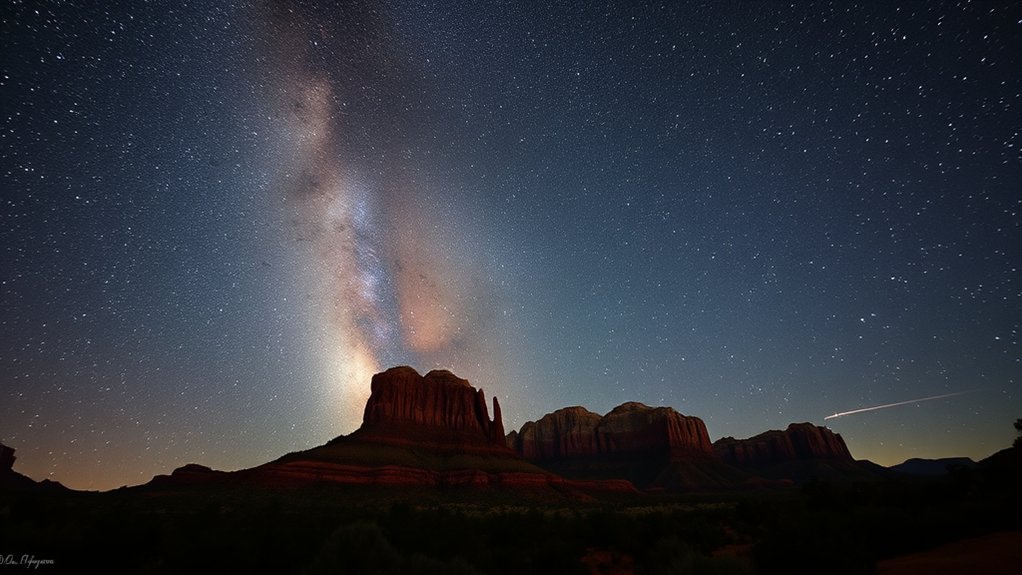
Lifting your gaze beneath Sedona’s vast, unpolluted skies, you’ll find a cathedral of stars that feels close enough to touch. You’ll notice the Milky Way arching bright, constellations sharp, and planets offering steady, jewel-like points. The dark-sky designation means minimal light scatter, so you’ll see more detail with the naked eye than you expect. Bring a blanket, a red-light flashlight, and patience; your eyes will take 20–30 minutes to adapt and then the cosmos opens up.
- Pick a high, open spot like Airport Mesa or Crescent Moon Picnic Area.
- Check moon phase and weather; new moon nights are best.
- Use a star app to identify constellations and satellites in real time.
- Join a guided stargazing tour for telescopes and expert narration.
- Respect dark-sky etiquette: low red lights, no flash photography, quiet conversation.
Stargazing here feels intimate and educational, turning a simple night into a memorable lesson in scale and silence.
Frequently Asked Questions
Are Pets Allowed on Sedona Hiking Trails and in Parks?
Yes — you can bring pets on many Sedona trails and parks, but you’ll need to keep them leashed, carry water, clean up waste, and avoid restricted areas; check specific trail rules and seasonal closures before heading out.
What Are the Best Times of Year to Avoid Crowds?
Late fall (November) and late winter (January–February) are best; you’ll avoid most crowds, enjoy cooler hikes, and see clearer skies. Shoulder months like March and October are quieter too, but can be busier around holidays.
Is Sedona Wheelchair or Stroller Accessible at Major Sites?
Yes — many major Sedona sites are wheelchair- and stroller-accessible: paved trails, viewpoints, visitor centers, and some park facilities. You’ll find ramps, accessible restrooms, designated parking, though some popular trails remain rugged and steep.
Are There Required Permits or Fees for Photography or Commercial Shoots?
Yes—you’ll need permits and fees for most commercial shoots on federal, state, or tribal land; think of them as keys granting access. Contact land managers, anticipate costs, apply early, and follow location-specific rules and insurance requirements.
How Safe Is Cell Phone and Internet Coverage Around Sedona?
Coverage’s mixed: you’ll get reliable cell and decent LTE around town and major trails, but you’ll hit dead zones on remote roads and some canyons. Bring offline maps, a portable charger, and download guides before heading out.
Conclusion
You’ve just skimmed Sedona’s highlights, but the desert holds more than a checklist — it’s a living palette. Hike red‑rock cathedrals at sunrise, sip farm‑fresh meals as light pools in canyons, and let starlight hush your thoughts. Like a well‑worn map folded into a pocket, each trail and viewpoint unfolds a new story; return often, move slowly, and you’ll find the landscape teaching you to breathe, notice, and belong.

